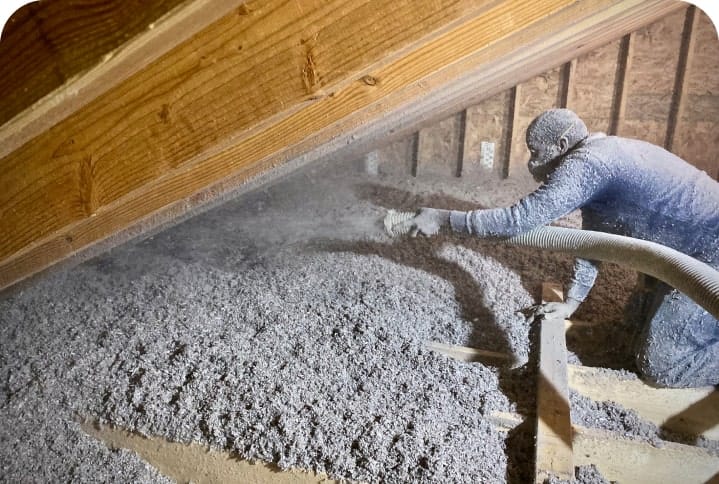
How Spray Foam Insulation Keeps Your Home Comfortable Year-Round eaglewatchroofing.com
When it comes to maintaining a comfortable home environment, insulation plays a vital role. Whether it’s the heat of summer or the chill of winter, proper insulation ensures that indoor temperatures remain stable and energy costs stay low. Among the various insulation options available today, spray foam insulation stands out as one of the most effective and energy-efficient solutions. It offers superior thermal resistance, airtight sealing, and long-term benefits that go far beyond traditional insulation materials like fiberglass or cellulose.
This article explores how spray foam insulation keeps your home comfortable year-round, highlighting its benefits, working mechanism, and long-term value for homeowners.
1. Understanding Spray Foam Insulation
Spray foam insulation is a two-part liquid mixture that expands into a dense foam when applied. It is typically made from polyurethane or isocyanate and polyol resin. Once sprayed, the foam expands rapidly to fill gaps, cracks, and crevices, forming an airtight seal. This expansion capability makes it highly effective at preventing air leakage — a common problem in older homes or poorly insulated spaces.
There are two main types of spray foam insulation:
Open-cell spray foam: Softer and more flexible, ideal for interior walls and soundproofing.
Closed-cell spray foam: Denser and more rigid, perfect for attics, roofs, and exterior applications where moisture resistance and high insulation values are crucial.
Both types provide outstanding thermal performance, but closed-cell foam offers a higher R-value, meaning it provides more insulation per inch.
2. The Science Behind Spray Foam Insulation
The key to spray foam’s effectiveness lies in its ability to seal air leaks and prevent energy loss. Traditional insulation materials only slow down heat transfer, while spray foam actively blocks it by filling every possible air gap.
In winter, warm indoor air naturally tries to escape through cracks and poorly sealed areas, causing drafts and uneven heating. In summer, the reverse happens — hot air from outside seeps in, making your air conditioning system work harder. Spray foam insulation solves both problems by creating a continuous thermal barrier that minimizes air exchange between indoors and outdoors.
By stopping heat transfer and air movement, spray foam helps your HVAC system operate more efficiently, maintaining consistent indoor temperatures without overworking.
3. Year-Round Comfort: How It Works
During Winter:
Spray foam insulation traps warm air inside your home, reducing the amount of heat that escapes through walls, ceilings, and floors. This means your heating system can maintain a cozy temperature without constant cycling. The airtight seal also blocks drafts, which are common sources of discomfort in colder months.
During Summer:
In warmer months, spray foam prevents hot outdoor air from entering your home and keeps conditioned air inside. As a result, your cooling system doesn’t have to run continuously, keeping indoor temperatures stable and your utility bills manageable.
This year-round temperature control not only increases comfort but also improves air quality by minimizing the infiltration of dust, pollen, and pollutants.
4. Moisture Control and Air Quality Benefits
Another significant advantage of spray foam insulation is its ability to resist moisture infiltration. Traditional insulation materials can absorb water, leading to mold and mildew growth that compromises both indoor air quality and structural integrity. Closed-cell spray foam, however, acts as a vapor barrier — it doesn’t absorb water and helps protect your home from potential damage caused by leaks or condensation.
Additionally, because spray foam creates an airtight envelope, it reduces the entry of outdoor allergens, dust, and pollutants. This results in cleaner, healthier indoor air, which is especially beneficial for families with allergies or respiratory conditions.
5. Noise Reduction for a Peaceful Home
While its primary purpose is insulation, spray foam also serves as an effective sound barrier. Open-cell spray foam, in particular, helps absorb sound waves, reducing noise transfer between rooms or from outside sources like traffic.
If you live in a busy neighborhood or have a home office that requires quiet, spray foam insulation can help create a peaceful environment that enhances your overall comfort.
6. Long-Term Energy Savings
Though the initial installation cost of spray foam insulation may be higher than traditional materials, it’s an investment that quickly pays for itself. By reducing heat loss in the winter and keeping cool air inside during the summer, homeowners can experience energy savings of up to 40% on utility bills.
Over time, these savings add up significantly, making spray foam not only an energy-efficient choice but also a financially smart investment. Furthermore, its durability means it won’t sag, compress, or deteriorate like fiberglass or cellulose, ensuring consistent performance for decades without replacement.
7. Environmental and Sustainability Benefits
With growing awareness of energy conservation and sustainability, spray foam insulation is gaining popularity as an eco-friendly home improvement solution. By enhancing energy efficiency, it reduces your home’s carbon footprint and minimizes reliance on heating and cooling systems.
Many manufacturers now offer spray foams that use low-global-warming-potential (GWP) blowing agents and renewable components, making them more environmentally responsible options.
8. Professional Installation Matters
While spray foam offers numerous benefits, proper installation is crucial for optimal performance. Professional installers use specialized equipment to apply the foam evenly and safely. They also ensure that the foam cures correctly, adheres well to surfaces, and achieves the right thickness for maximum efficiency.
DIY installation is not recommended, as improper application can result in uneven coverage, off-gassing, or insulation gaps that compromise effectiveness. Hiring an experienced insulation contractor ensures your investment delivers long-lasting comfort and performance.
9. Durability and Maintenance-Free Performance
One of the biggest advantages of spray foam insulation is its longevity. Once installed, it does not settle or degrade over time. Unlike fiberglass, which can compress or lose effectiveness, spray foam maintains its shape and performance for the life of the building.
Because it’s resistant to moisture, pests, and air leakage, it requires virtually no maintenance — providing peace of mind and consistent comfort for years to come.
10. The Bottom Line: Comfort That Lasts All Year
In essence, spray foam insulation is a smart, long-term solution for homeowners seeking year-round comfort, lower energy costs, and a healthier living environment. It goes beyond traditional insulation by providing superior air sealing, moisture protection, and thermal resistance.
Whether you’re building a new home or upgrading your existing insulation, spray foam offers an effective way to:
Maintain consistent indoor temperatures
Improve indoor air quality
Reduce energy bills
Protect your home from moisture and mold
Enjoy peace and quiet all year long
Final Thoughts
A comfortable home isn’t just about the right thermostat setting — it’s about having the right insulation working behind the scenes. Spray foam insulation ensures your home stays warm in winter, cool in summer, and energy-efficient all year round. With its proven performance and long-term savings, it’s no wonder more homeowners are making the switch to spray foam insulation for lasting comfort and peace of mind.
Report Story

